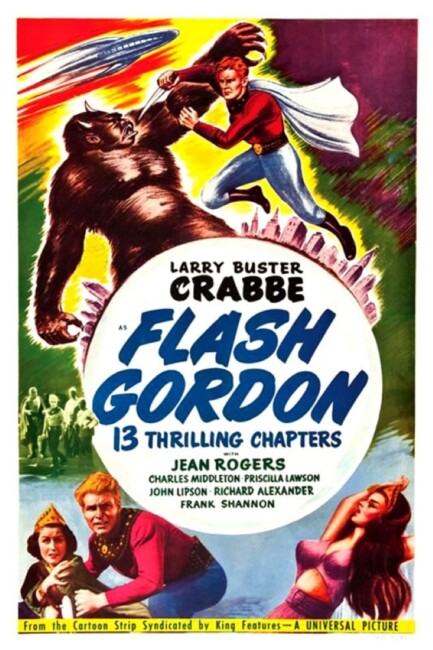aka Space Soldiers
USA. 1936.
Crew
Director – Frederick Stephani, Screenplay – Basil Dickey, Ella O’Neill, George Plympton & Frederick Stephani, Based on the Comic Strip Created by Alex Raymond, Producer – Henry MacRae, Photography (b&w) – Jerry Ash & Richard Fryer, Electrical Effects – Norman Dewes, Art Direction – Ralph Berger. Production Company – Universal.
Cast
Larry ‘Buster’ Crabbe (Flash Gordon), Jean Rogers (Dale Arden), Frank Shannon (Dr Zarkov), Charles Middleton (Emperor Ming), Priscilla Lawson (Princess Aura), John Lipson (King Vultan), Richard Alexander (Prince Barin), James Pierce (Prince Thun), Theodore Lorch (High Priest), Duke York, Jr. (King Kala)
Plot
The planet Mongo is heading towards Earth on a collision course, creating vast storms in its wake. One such storm causes a small transcontinental plane carrying polo player Flash Gordon, the son of an astronomer who is observing the nearing collision, to crash. Flash bails out along with fellow passenger Dale Arden and they land at the home of scientist Dr Zarkov. Zarkov forces them to join him as he launches his homemade rocket to land on Mongo. There they are captured and taken before Ming, the self-styled Emperor of the Universe. Zarkov persuades Ming to stop Mongo’s headlong path but Ming then decides he will conquer the Earth instead. Ming also decides that he will marry Dale. Ming has Flash thrown in the arena but his daughter Princess Aura decides that she wants Flash for herself and intervenes to save him. They escape, hotly pursued by Ming’s soldiers, and travel to the underwater city of the Shark Men and then the Sky City of the Hawkmen. All along the way, Flash gathers allies among the peoples of Mongo as he tries to bring down the evil of Ming’s tyranny and save Dale from her fate.
Flash Gordon is one of the classic heroic characters in science-fiction. Created by Alex Raymond, Flash Gordon began in 1934 as a syndicated newspaper comic-strip from King Features Syndicate. The original intention was to create another space opera adventure in the vein of Buck Rogers in the 25th Century, which had begun as a newspaper strip in 1929 and had proven a considerable success with the public. In a rapid space of time however, Flash Gordon became a rival that outshone Buck Rogers, particularly in terms of the far more sophisticated artwork of the strip. Most of the early stories concern Flash, Dale and Dr Zarkov’s adventures throughout the various kingdoms of Mongo in an attempt to stop Ming’s evil skulduggery, although later plots expanded their adventures out to other planets. Apart from a stint in the Army in World War II, Alex Raymond worked on the strip until his death in a car accident in 1956. Flash Gordon still continues as a newspaper strip today and has been drawn and written by a number of others, including science-fiction writer Harry Harrison, best known for The Stainless Steel Rat and Soylent Green (1973); celebrated fantasy artist Frank Frazetta; and Harvey Kurtzman, the creator of Mad magazine.
Outside of the comic-strip, Flash Gordon has enjoyed a great many other incarnations, including four different television series, both in live-action and animated (see below); a radio serial that ran between 1935 and 1936; an attempt to launch a pulp magazine Flash Gordon’s Strange Adventure Magazine (1936) that saw only one issue ever published (which has since become a collector’s item); two different series of six books apiece from different publishers during the 1970s and 80s; not to mention various other incarnations and reprints of the comic-book. By far, the most famous incarnations of Flash Gordon were as this serial and its two sequels, which have become so famous they have even supplanted the fame of the comic strip in some areas.
Serials were a fad that began in 1912 and continued through until 1956. A serial was an ongoing adventure, usually in twelve or fifteen chapters, that each week would end with the hero or heroine placed in some life-threatening danger (hence the term cliffhanger) and audiences would have to return the following week to find out how they survived. Almost all serials were intended for juvenile audiences and would run for around 15-20 minutes before the main feature began. There were dozens of these made, covering superheroes, Western, spy, jungle and crime adventures, and a handful of space operas, of which Flash Gordon served as an imprimatur for the others that would follow. What should also be said about most serials is that they were very cheaply and primitively made – footage was often recycled between serials. The serial died away in the 1950s, at exactly the time when television came to supplant cinema as a form of entertainment.
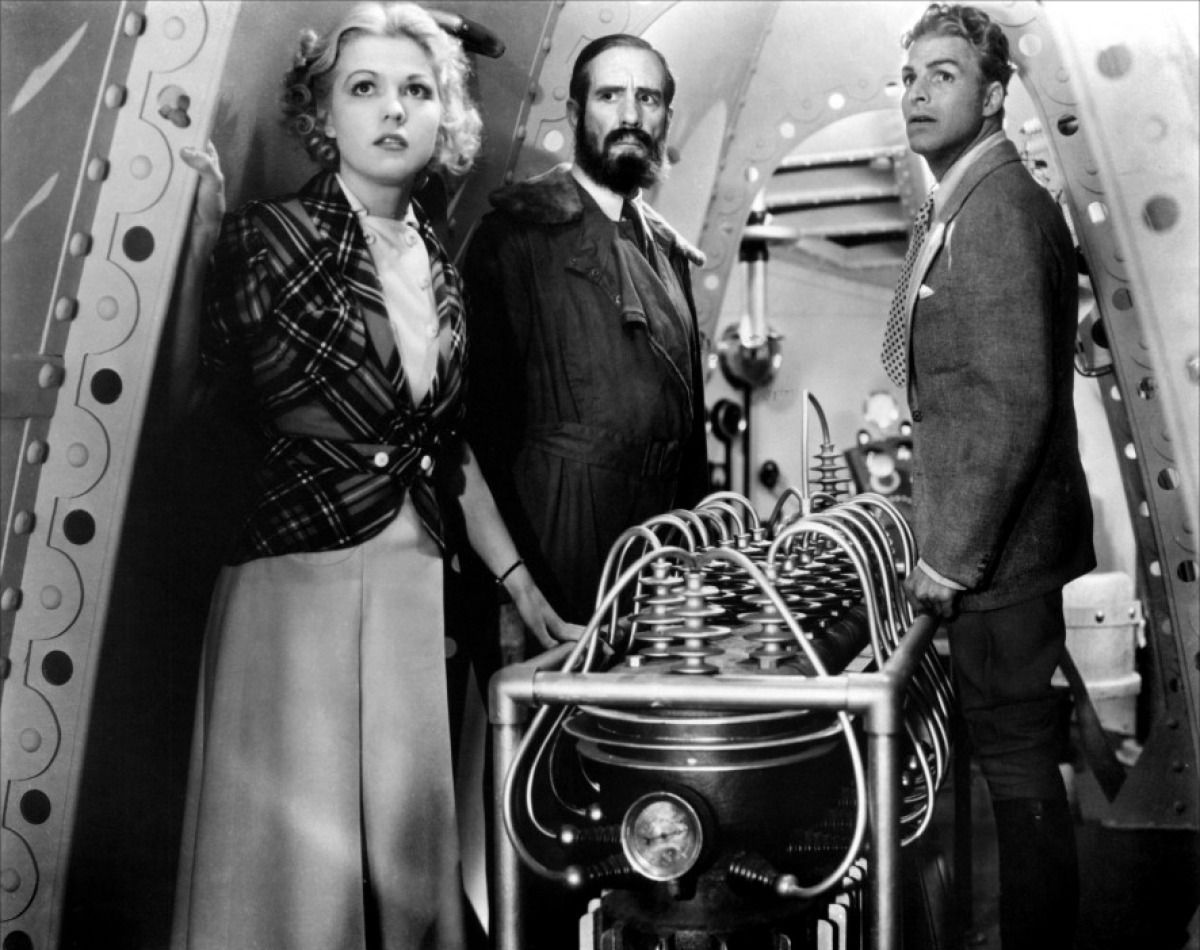
Among the impoverished surroundings of the serials, Flash Gordon is usually regarded as one of the very best (and was certainly the most expensive) ever produced. The sets manage to be amazingly expensive, especially when the miniscule budgets that most serials had is taken into consideration. (The production designers apparently based many of the sets directly on the designs in the comic-strip). Especially good is Ming’s throne room, which may look a little threadbare by today’s standards but has clearly been designed for big-screen effect. Some of the film is padded out by stock footage from other Universal films of the era – notably the exotic dancers cavorting around a six-armed statue from Just Imagine (1930) and the reuse of sets from other Universal films like The Mummy (1932) and Bride of Frankenstein (1935).
There is also a much better story to Flash Gordon than most other serials of the era. (This very faithfully follows about the first year of Alex Raymond’s comic-strip storyline). For once in a serial, this is not something that is dragged out by an endless series of artificial plot devices to obtain various components or antidotes and counter plots etc. Perhaps in the last quarter of the show, there is a little too much running around the palace and scenes with Flash being thrown in the arena and given forgetfulness drugs. These tend to feel like they are padding the plot out and lack the vivid sense of adventure that the earlier scenes venturing through the various kingdoms do. There is also some slightly incredulous character psychology at times – like how Princess Aura is persuaded to give up her infatuation with Flash after just a single kiss from Barin; and particularly the ending, which is a little flat in terms of a modern hero/villain showdown, where Flash just accepts the word of the priest that Ming has perished in the Temple of Tayo and gives up and goes home without any confirmation of this (no doubt to set the stage for further sequels).
There is however something wonderfully exciting about Flash Gordon. It seems to capture the very essence of the E.E. ‘Doc’ Smith space opera. This is none more evident than the opening few minutes where the meteorite strikes the plane and Flash and Dale are forced to bail out (after the turbulence throws them into one another’s arms) amidst what looks like WWI aerial barrage footage. Upon landing, they are abducted at gunpoint by Dr Zarkov in his wonderfully squat (and undeniably phallic-looking) rocketship – something that was wittily parodied in Flesh Gordon (1974). The takeoff, amid sparks farted from the rocket’s rear and them sitting at controls that look like pressure gauges in a boiler room, is equally wonderful. Then comes the landing on Mongo with images of the rocketship circling a castle that has been built atop an entire mountainside (a shot that will be reused several times throughout the serial) and being attacked by an optically enlarged lizard, followed by the arrival of a rocketship of imperial guards that emerge in embossed armour and metal helmets like some alien equivalent of Ned Kelly associates.
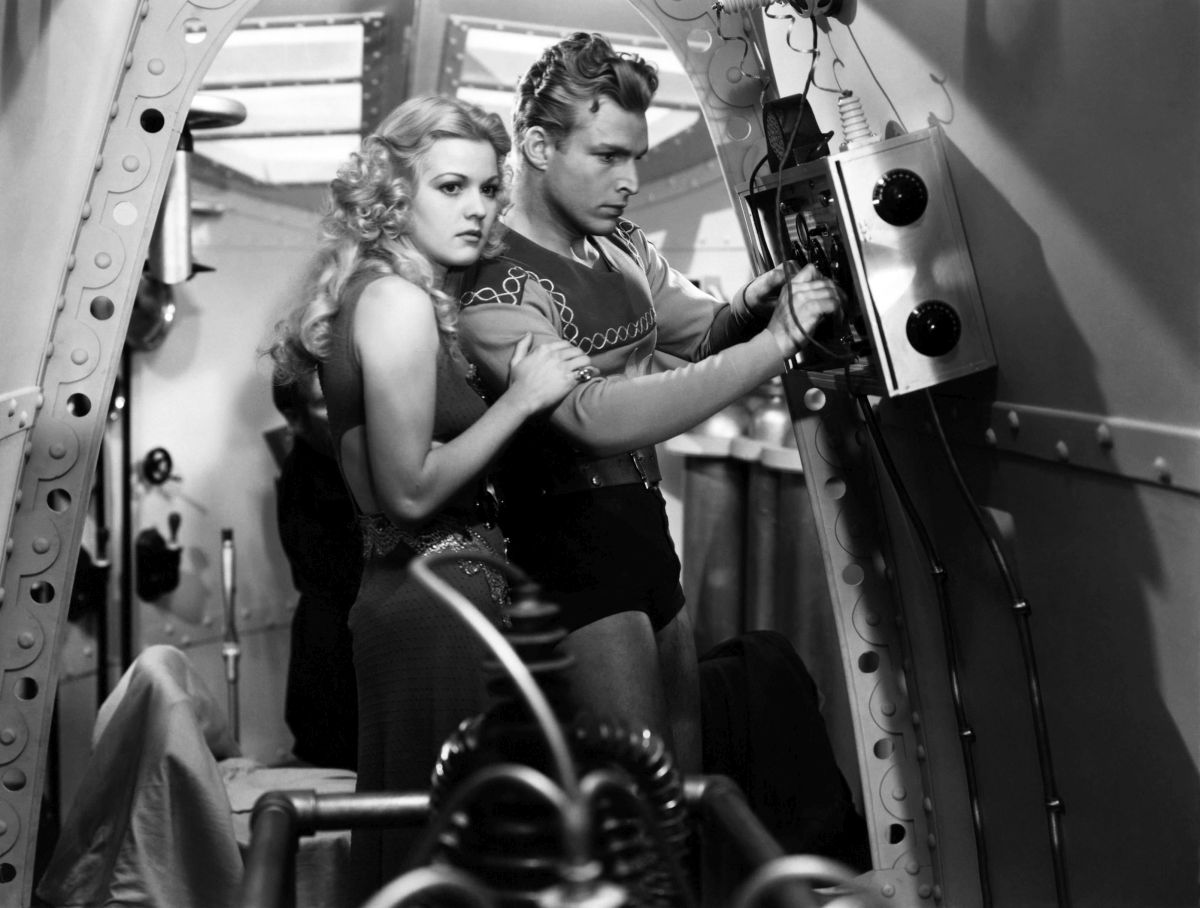
Within the opening moments of this first chapter – and no matter how primitive the special effects seem today – audiences of the era were transported to a new place. There had been space travel depicted on screen before – films like Georges Melies’ A Trip to the Moon (1902), Fritz Lang’s Woman in the Moon (1929) and various lost films of the silent era – but these had mostly been dull and serious efforts, focusing on the construction of the rocketship or the journey there. No other science-fiction film before Flash Gordon had created an adventure that took audiences into such an exotic realm of pure adventure.
Mongo is a realm that has been distilled from every other adventure story and genre of the era. It is a domain that combines both advanced science and pulp gadgetry and a culture modelled on the Roman Empire. It is lorded over by a villain who is distinctly Asian in looks (Asian villains were big in this era, most notably in Sax Rohmer’s Fu Manchu stories and numerous imitators). There are encounters with exotic creatures that are the animals that one might meet in an adventure story (lions, sharks, hawks, apes, tigers, octopi), having been turned into human form or dressed up with exotic names. And Flash is no more than a variant on a cowboy hero who acts in terms of black-and-white certainties.
The action is immensely exciting and the cliffhangers are far superior to any other serial of the era. Larry ‘Buster’ Crabbe manages to look wonderfully dashing wielding swords against soldiers and masked swordsmen, fighting with the orangapoid or wrestling beast men as his shirt becomes artfully torn. Crabbe also appears to be doing his own stunts throughout too. He goes through a real workout – like the sequences where he and Thun are stripped to their waists and whipped while being forced to shovel radium into the furnaces (while unshielded too – no wonder the rest of the prisoners look so emaciated) or is tortured by Ming by being winched, still bare-chested, down into an arcing electrical device strapped into a frame.
There is a wonderful imagination to the serial that seems only barely contained by being relayed through inadequate effects – fabulously fantastical images like the Shark Men’s city being released from its moorings to float up to the surface, the Hawkmen flying in attack formation, the Hawkmen’s city floating in the clouds on beams of light. The constant poverty of the effects – optically enlarged lizards, stock footage of a shark for when the octosac attacks, weak model effects that are repeated several times throughout, scratched-over raybeams, a melting ray that threatens the rocketship being no more than a spotlight – are the only thing that let down the fabulous imagination on display. Nevertheless, what there is managed to inspire a generation of fans – notedly George Lucas who wanted to make his own series of Flash Gordon films, could not obtain the rights and so decided to create his own space opera adventure with Star Wars (1977).
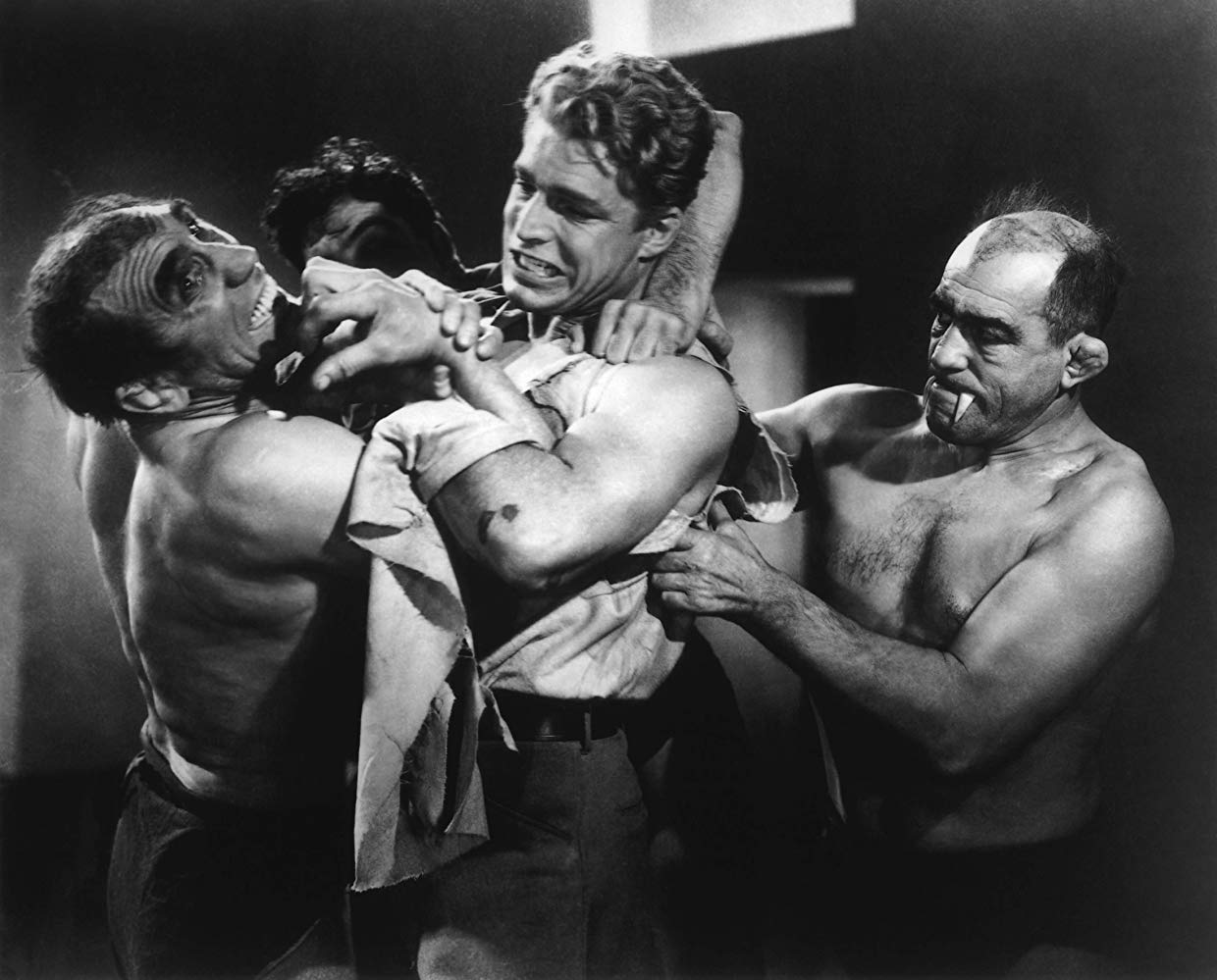
The design of the film is fabulous. It is important to note that Flash Gordon was made in the era when electrics (but not electronics), the telephone and radio were considered cutting edge technology. The rocketship is all riveted metal bulkheads, flywheels, valves and pressure gauges – it is a wonderful vision of space travel and a future that might have been made before the arrival of television and the computer, let alone electronics and the silicon chip.
The costumes are wonderful. Jean Rogers looks incredibly sexy in a series of gowns that have been designed with bikini tops and bared midriffs. Ming comes in a series of impressive high-necked gowns and wraps; Flash is outfitted in some nifty tunics and trunks; while the Universal historical wardrobe department has been raided to outfit the imperial guards with Roman centurion outfits.
On the other hand, the costuming and design seems to have fallen somewhat short when it comes to depicting the exoticism of the various alien species that inhabit Mongo. The Lion Men come with no more than big beards; the Shark Men are merely outfitted in trunks, bathing helmets and strange boots; the orangapoid is merely an actor in an ape-suit with a horn planted on its forehead; while the tigon is simply a tiger. The most effective of these are the Hawkmen who come outfitted with winged helmets and giant oversized wings on their backs.
Larry ‘Buster’ Crabbe had come from success as a swimmer at the 1928 and 1932 Olympics, winning a gold medal in the 400-Meter Freestyle at the latter. Attempting to replicate the success that MGM had had in casting Olympic gold medal winning swimmer Johnny Weissmuller as Tarzan in Tarzan the Ape Man (1932) and sequels, Crabbe had first been cast as Kaspa, a Tarzan copy, in King of the Jungle (1933), and then as Tarzan in the independent serial Tarzan the Fearless (1933), before finding fame in the Flash Gordon serials and then as Buck Rogers (1939). With Romanesque nose, Crabbe has a wonderful profile and plays the part with a humourless autocratic conviction that leaves you unquestionably certain that he is the hero of the show.
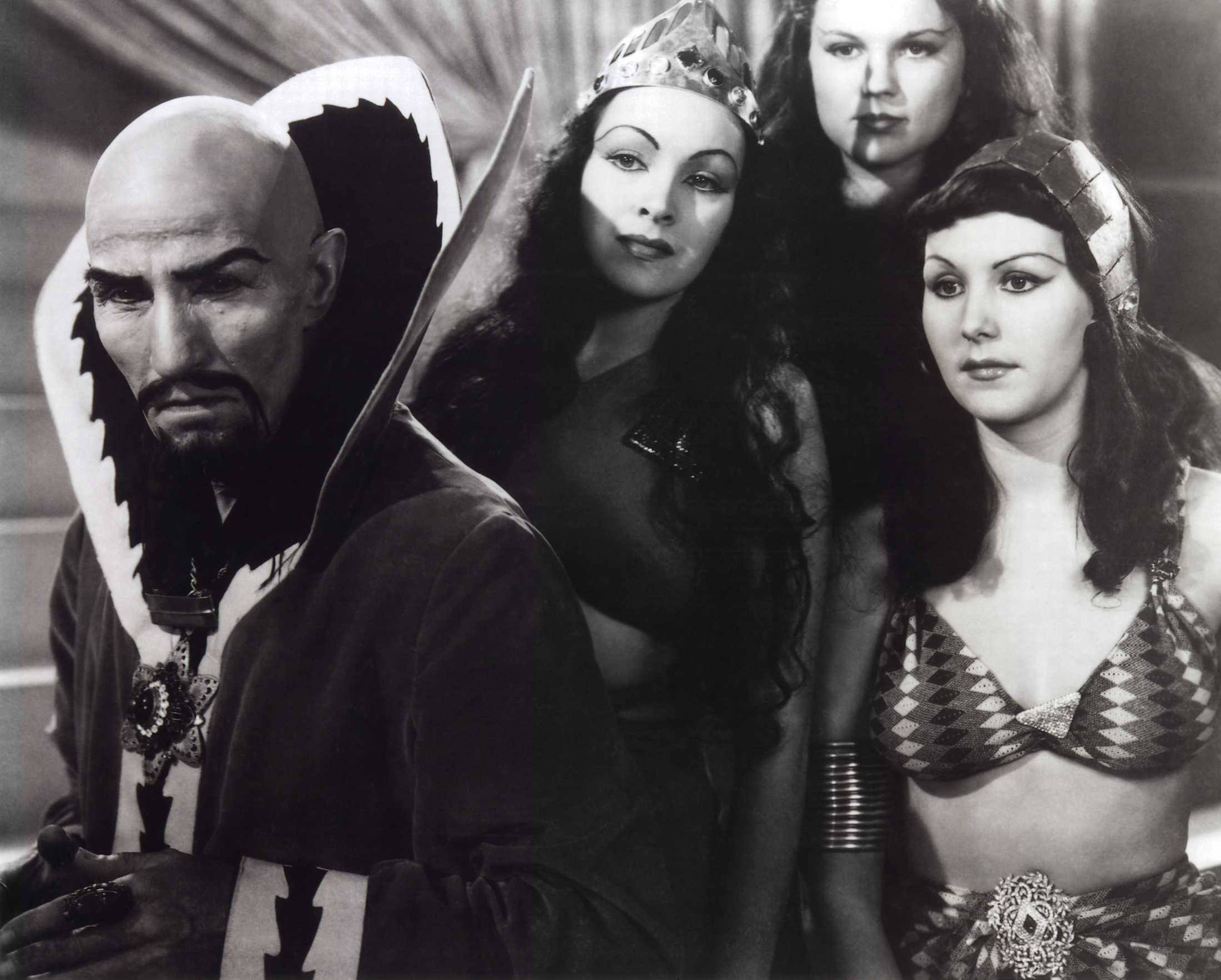
Ming is played by Charles Middleton, an actor who appeared as a baddie in numerous Westerns. The role of Ming is fabulous, although rather than inflate it with the grand presence that Max Von Sydow did in the 1980 remake or other villains modelled on the role like Darth Vader, Charles Middleton plays the part with a flinty mean-mindedness. The great Jean Rogers immediately makes one think of comparisons to Fay Wray in King Kong (1933), which almost certainly had some influence on the role. Rogers plays with a combination of feisty bubbliness and wholesome innocence. There seem few more potent sights of her purity and innocence (and Ming’s evil) than the vision of her in bikinied gown being hypnotised by Ming and made to agree to marry him. One of the scene-stealers of the show is Priscilla Lawson as Ming’s daughter Aura. She plays the part to the hilt with a series of archly seductive expressions. Just the way she caresses Flash’s arms while they are hiding in the caverns leaves no doubt as to what her intentions are. Throughout the serials, Frank Shannon seemed a little out of it playing Dr Zarkov. Although to his credit, Zarkov was about the only scientist of the era that seemed to be on the side of good (let alone doing legitimate scientific research). John Lipson gives an entertainingly boisterous performance, madly laughing his head off, as Vultan.
The subsequent serials were Flash Gordon’s Trip to Mars (1938) and Flash Gordon Conquers the Universe (1940). Larry ‘Buster’ Crabbe, Charles Middleton and Frank Shannon appear in all of these, while Carol Hughes replaced Jean Rogers in the third. Spaceship to the Unknown (1966) is a condensed feature-length version of Flash Gordon that was edited for television and is still in circulation.
The character of Flash Gordon was revived in a short-lived live-action tv series Flash Gordon (1954) starring Steve Holland, which is poorly regarded by fans due to its extremely cheap budget. The serial was cinematically remade by producer Dino De Laurentiis as Flash Gordon (1980) starring Sam Jones – much of the remake appeared to take itself directly from the serial more so than the comic-books, particularly in the plot about Ming trying to marry Dale, Aura’s rescue of Flash and his journey to unite the various kingdoms, and especially Brian Blessed’s Vultan, which is clearly modelled on John Lipson’s gregarious performance here. The 1980s film plays the elements of the serial/comic-book as camp and has a divided reputation with fans of the original. At the same time, Dino De Laurentiis in conjunction with Filmation also sponsored an animated tv series Flash Gordon/The New Adventures of Flash Gordon (1979), which lasted for sixteen episodes. There was a subsequent animated series Flash Gordon (1996), which recast the central characters as teenagers. Flash also appeared in the animated Defenders of the Earth (1986), alongside other King Features comic-book characters The Phantom and Mandrake the Magician. Flash Gordon (2007-8) was a live-action remake for television starring Eric Johnson as Flash, although this widely varies from the familiar elements of the comic-books and serials. During the 00s, directors Stephen Sommers and Breck Eisner were at various point purported to be considering a big-budget live-action remake. Indeed, Flash Gordon is a property that seems to be crying out for a decent, serious modern remake.
Flash Gordon was parodied as the softcore pornographic Flesh Gordon (1974), which had a sequel in Flesh Gordon Meets the Cosmic Cheerleaders (1991), and more sophisticatedly in the witty Star Trek: Voyager episode Bride of Chaotica (1999). Flash also gets a line in the opening song Science-Fiction Double Feature in The Rocky Horror Picture Show (1975). In a cute touch, Larry ‘Buster’ Crabbe also played an aging military officer Brigadier ‘Flash’ Gordon in the Planet of the Slave Girls episode of the tv series revival of Buck Rogers in the 25th Century (1979-81).
Trailer here
All twelve chapters online beginning here:-


